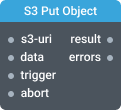S3 Put Object
Uploads an object to an S3 bucket.

In-ports
s3-uri String — the location of the S3 object to upload.
data <any> — the content to write.
trigger <any> — triggers the S3 request.
abort <any> — aborts all pending requests.
config JSON (dynamic) — accepts a JSON object with configuration properties that can be set at runtime.
Out-ports
result JSON — response wrapped into JSON object.
errors JSON — emits any errors that occur during action execution.
Overview
The S3 Put Object component adds an object to a specified S3 bucket. This component is part of the group of components that are designed to perform operations with Amazon S3.
To use this component, send an S3 URI of the object to the s3-uri port and the contents to the data port. S3 URI indicates an S3 location in the format s3://amzn-s3-demo-bucket/mykey, where amzn-s3-demo-bucket is the bucket name and mykey is the key. The contents can be anything, such as JSON, Blob, or String.
You cannot use this operation to update a single piece of metadata for an existing object; the entire object must be uploaded with updated metadata.
If the trigger input port is used, the component waits until an event is received before executing the action. The action is performed with each event. Errors encountered will be emitted on the errors output port. Use the abort port to cancel the execution.
Upon successful execution, an HTTP 200 response is returned.
Settings
Enable realtime config port
When enabled, this setting allows the component to be configured via the config port. The port accepts a configuration object as input, enabling dynamic property updates during runtime. While using this port won't trigger component reinitialization, it may result in the loss of some previous component state.
Region (region)
The AWS region in which the S3 client operates.
- Required: Yes
Keep always active
Determines whether the component will remain active even if it is not connected to a visible widget or another active component.
Related
See also
For more information about Amazon S3, see the following: